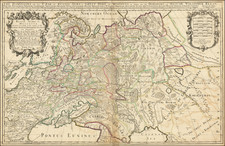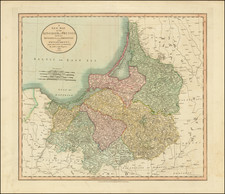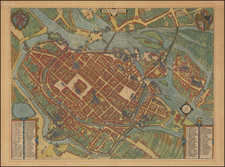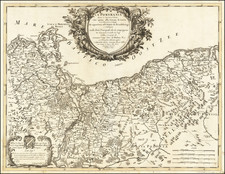Mapping The Russian Army Movements of Field Marshall Bütturlin During the Seven Years War
Remarkable hand drawn field map illustrating the march routes of the Russian army during 1761, under the command of Field Marshal Count von Bütturlin.
Oriented with east at the top of the map, covering the area north of the east of the Oder River, the map shows a detailed account of the Theater of War and the route (in red) covered by the Russian forces led by Bütturlin. The map and accompanying data offers a vivid and detailed representation of military movements in a theater of the Seven Years' War (1756–1763), which involved most of the great powers of the time and took place across several continents, but most notably in Europe.
In addition to the route map, the table at the right includes a meticulous accounting of the 80 sites where the Army camped between May 19, 1761 and November 25, 1761, including the name of the location, date and distance travelled in German miles. The expedition covered a total of 148 1/2 miles.
Historical Context of the Seven Years' War
The Seven Years' War was a global conflict that predates the concept of a "world war" but fits the criteria in scope. It pitted the coalition of Great Britain and her allies against a coalition led by France and included the Austrian-led Holy Roman Empire, Russia, Spain, and Sweden. This war saw theaters of conflict ranging from Europe to North America, the Indian Subcontinent, and West Africa.
The Russian Army in the Seven Years' War
The Russian Empire, under Empress Elizabeth, entered the war on the side of Austria in 1756, seeking to limit the growing power of the Kingdom of Prussia under Frederick the Great. The maps depict the movements of the Russian army, which played a significant role on the Eastern Front of the conflict. Bütturlin's army maneuvered through territories that are now part of modern-day Poland, Germany, and the Baltic states.
Count von Bütturlin
Field Marshal Count Peter Alexandrovich von Bütturlin (Pyotr Aleksandrovich Buturlin in Russian transliteration) was a Russian nobleman and military leader. Though not as widely recognized as some of his contemporaries, Bütturlin held significant commands during the Seven Years' War. His role in 1761, particularly in the regions mentioned, was part of Russia's broader military strategy against Prussia.
Military Campaigns of Bütturlin in 1761
In 1761, Bütturlin's army was instrumental in the Russian effort to weaken Frederick the Great's hold over various strategic territories. The marches through Lower Silesia, New March (Neumark), and Pomerania represented a concerted effort by the Russian Empire to apply pressure on the eastern flanks of Prussian domains. Bütturlin's forces were involved in a series of maneuvers that were geared towards sieges and holding key territories. The movements through these regions were indicative of a strategy that sought to outmaneuver Prussian forces and to lay siege to their fortresses. One of the critical engagements was the siege of Kolberg, where Russian and Austrian forces aimed to secure the port city, which was crucial for Baltic maritime routes and Prussian supply lines.
At the bottom left, the remarks section translates as follows:
Remarks on the Marches of 1761.
I. From Marienburg to Posen, the Army marched in three columns, which assembled near Posen in Posnania.
II. From Posen, the Army marched together until Zirpow, and from Zirpow, the first Division began to march separately.
III. In the environs of Stargard, the Russian Army was rejoined by the third column of the Army of Observation under the command of General Laudon, where they rejoined the Pomeranian Army. It was at Stargard that the Corps of General Czernichev met, and the other Russian troops recrossed the Oder near Stettin.
IV. The third Division, under the command of General Major Count Dolgorouki, received orders in Schmargendorf to go and join the Corps of Count Romanzov before Colberg in Pomerania.
V. From Zirpow, the first Division commanded by General-in-chief Count Fermor began to march separately.
VI. From Tempelburg, a corps was detached on the march under the orders of Prince Wolgonski. It only rejoined on the 8th of August. The Regiment of Vistula, which had marched separately, also rejoined at this time.
Note. The General Quarters, which the General Quartermaster of Cavalry had marked out for 109 days of the campaign, correspond to 80 marches and extend to 148 1/2 German Miles over 110 days."












![(Second World War - Eastern Front) [The Soviet Encirclement of Konigsberg]](https://storage.googleapis.com/raremaps/img/small/65659.jpg)
![[ Southern Ukraine / Mykolaiv Oblast / Kherson ] Die Otschakowische Tartarey Oder Westliches Nogaj Auc Jedistan](https://storage.googleapis.com/raremaps/img/small/102019.jpg)
